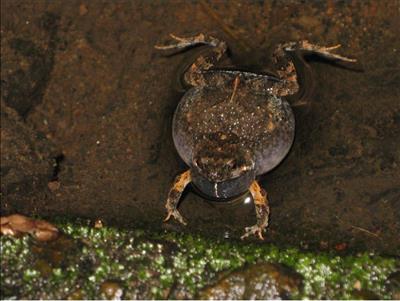Farris Lab
Research at the Farris Lab focuses on the neurobiology and behavior of sensory processing. Grounded in the field of neuroethology, the Farris Lab works with diverse taxa to understand the limits of discrimination and detection of visual and auditory communication signals. Continuing the traditions developed by the Kresge Hearing labs at LSUHSC; The Department of Otorhinolarynology and Biocommunications; and Profs. Douglas Webster PhD, Charles Berlin PhD, and Richard Bobbin, PhD, the Farris Lab employs the experimental and analytical methods of neurophysiology; evolutionary biology; developmental biology; and psychophysics to untangle the mechanisms and evolution of perception.

Hamilton Farris, Ph.D.
Dr. Farris is an Associate Professor in the Neuroscience Center's Cell Biology and Anatomy Department and the Department of Otorhinolaryngology and Biocommunication. Dr. Farris earned his PhD in Neurobiology and Behavior from Cornell, and completed post-doctoral work at University of Texas- Austin and the LSU Health Sciences Center.
Research interests include communication, speech, attention, complex auditory stimuli. Using the methodologies of psychophysics, neurophysiology and evolutionary biology, our research explores the underlying neural mechanisms mediating sensory acuity (i.e., stimulus detection and discrimination). Our long-range goal is to understand how components of descending circuitry contribute to the ability to communicate in noisy environments.
Farris Research Team
Whitney Walkowski - Graduate Student
Elizabeth Alexis - Graduate Student
Twila Gaston - Honors Medical Student
Farris Lab Research Highlights
Recent work has focused on understanding what determines visual sensitivity. We have shown that in addition to optical anatomy, there is endocrine modulation of retinal responses to light, potentially contributing to reproductive specific visual processing.
Leslie, CE, Rosencrans, RF, Walkowski, W, Gordon, WC, Bazan, NG, Ryan, MJ, Farris, HE. (2020) Reproductive state modulates retinal sensitivity to light in female túngara frogs. Front. Behav. Neurosci. 13:293. doi: 10.3389/fnbeh.2019.00293
Rosencrans RF, Leslie CE, Perkins KA, Walkowski W, Gordon WC, Richards-Zawacki CL, Bazan NG, Farris HE. (2018) Quantifying the relationship between optical anatomy and retinal physiological sensitivity: A comparative approach. Journal of Comparative Neurology, 1-13. https://doi.org/10.1002/cne.24531
Read More at Frontiers in Behavioral Neuroscience
Since the founding of the field of psychophysics, it's been well been known that stimulus processing is based on logarithmic or power scales. That is, ratio, rather than absolute changes in stimulus magnitude are required for observers to perceive just noticeable differences in stimulus parameters. This means that of the available stimuli that bombard a sensory system, perception of similarity (cf. Gestalt psychology) is based on relative differences.
Farris, H.E., and Ryan, M.J. (2011) Relative comparisons of call parameters enable auditory grouping in frogs. Nature Communications. Vol. 2: doi: 10.1038/ncomms1417.
Farris, H.E. and Ryan, M.J. (2017) Schema vs. primitive perceptual grouping: The relative weighting of sequential versus spatial cues during an auditory grouping task in frogs, Journal of Comparative Physiology A. DOI 10.1007/s00359-017-1149-9
Read More in the Journal of Comparative Physiology
Given that ratio coding is likely universal among sensory systems, our data added a new paradigm explaining the evolution of communication signals. This generated a paper in Science with a featured editorial. The impact of this paper resulted in an invitation to publish a perspective on ratio coding, also in Science.
Akre [FH1];, K.L., Farris, H.E.*, Lea, A.M., Page, R.A., and Ryan, M.J. (2011) Signal perception in frogs and bats and the evolution of mating signals. Science.333 (6043), 751-2. *equal author contributions
Farris, H.E. (2017) Perception drives the evolution of observable traits. Science Vol. 355, Issue 6320, pp. 25-26 DOI: 10.1126/science.aal4193
In collaboration with Dr. Tony Ricci, my work found that the [Ca2+] of endolymph determines the resting transduction current in hair cell stereocilia. We further investigated the identity of the transduction channel and provided the most complete pharmacological and dimensional profile to date.
Farris, H.E., LeBlanc, C.L., Goswami, J. and Ricci, A.J. (2004) Probing the pore of the auditory hair cell mechanotransducer channel in turtle. Journal of Physiology, 558.3, 769-792.
Farris, H.E., and Ricci, A.J. (2005) Voltage-clamp errors cause anomalous interaction between independent ion channels. Neuroreport, 16, 943-947.
Farris, H.E., Wells, G.B. and Ricci, A.J. (2006) Steady-state adaptation of mechanotransduction modulates the resting potential of auditory hair cells, providing an assay for endolymph [Ca2+]. Journal of Neuroscience. 26, 12526-12536.
In my collaboration with Dr. Jennifer Lentz here at LSUHSC, I contribute to the effort to overcome forms of human hereditary deafness. This work has widespread implications for the treatment of deafness and vestibular dysfunction, as well as for treating other sensory deficits, including blindness.
Lentz, L. Gordon W.C. Farris, H.E., MacDonald, G. Robbins, C.A., Tempel, B.L., Bazan, N.G., Rubel, E., Oesterle, E., Keats, B. (2010) Deafness and retinal degeneration in a novel USH1C knock-in mouse model. Developmental Neurobiology, 70, 253-67.
Lentz, J., Jodelka, F, Hinrich, A., McCaffrey, K., Farris, H.E., Spalitta, M., Bazan, N., Duelli, D., Rigo, F., Hastings, M. (2013) Rescue of hearing and vestibular function by antisense oligonucleotides in a mouse model of human deafness. Nature Medicine doi:10.1038/nm.3106
Ponnath, A., Depreux, F., Jodelka, F., Rigo, F., Farris, H.E., Hastings, M., Lentz, J. (2018) Rescue of outer hair cells with antisense oligonucleotides in Usher mice is dependent on age of treatment, Journal of the Association for Research in Otolaryngology. DOI: 10.1007/s10162-017-0640-x
Dr. Farris' Complete List of Pubished Work
Farris Lab Research Photos
 |
Gamboa, PanamaField work is conducted at the Smithsonian Tropical Research Institute, at labs in Gamboa, Panama
|
 |
Singing Tunara FrogThe primary research focus is the auditory grouping capabilities of Tungara frogs. |
